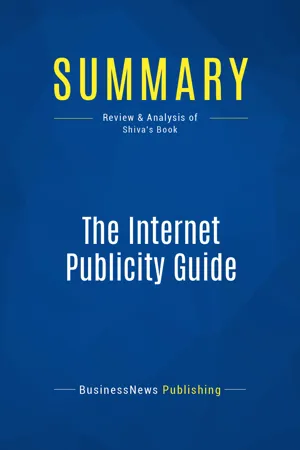
Summary: The Internet Publicity Guide
Review and Analysis of Shiva's Book
- English
- ePUB (mobile friendly)
- Available on iOS & Android
About this book
The must-read summary of V. A. Shiva's book: `The Internet Publicity Guide: How to Maximize Your Marketing and Promotion in Cyberspace`.
This complete summary of the ideas from V. A. Shiva's book `The Internet Publicity Guide` shows how the internet has become a part of the communications revolution, offering individual consumers the ability to have personalised multimedia communications with other people or companies anywhere in the world. In this book, the author explains that your ultimate goal should be to build profitable relationships by communicating your Web presence to others on the internet and getting qualified visitors to visit your site. This summary explains exactly how you can do that and succeed at internet publicity with helpful tips and strategies that you can apply to your business.
Added-value of this summary:
• Save time
• Understand key concepts
• Expand your knowledge
To learn more, read `The Internet Publicity Guide` and find out how you can enhance your online image and promote your products.
Frequently asked questions
- Essential is ideal for learners and professionals who enjoy exploring a wide range of subjects. Access the Essential Library with 800,000+ trusted titles and best-sellers across business, personal growth, and the humanities. Includes unlimited reading time and Standard Read Aloud voice.
- Complete: Perfect for advanced learners and researchers needing full, unrestricted access. Unlock 1.4M+ books across hundreds of subjects, including academic and specialized titles. The Complete Plan also includes advanced features like Premium Read Aloud and Research Assistant.
Please note we cannot support devices running on iOS 13 and Android 7 or earlier. Learn more about using the app.
Information
Summary of The Internet Publicity Guide (V.A. Shiva)
PART 1
THE INTERNET
- How the Internet is structured
- Seven basic Internet concepts
- Tools of the Internet based trade
- How to get on to the Internet
- Being on the Internet
- Setting up shop on the Internet
- Security and copyright Issues
1. How the Internet evolved
2. Seven basic Internet concepts
- The Internet is a means to an end and not an end in and of itself. It is a communication system in which every member can both send and receive information.
- Every user is equal on the Internet, irrespective of and independent of traditional factors such as resources, physical location, etc.
- The Internet is not under the control of anyone – no official or government approvals are required to use or do business over the Internet.
- Community standards have evolved with regards to the Internet, and you need to become familiar with these standards if you intend succeeding.
- The Internet is people-based, not government-based.
- The Internet is a level playing field. The traditional prejudices with respect to nationality or background are irrelevant.
- A culture has developed around the use of the Internet which must be respect if you expect to succeed in any Internet based business venture.
3. Tools of an Internet based trade
- E-Mail: Electronic Mail E-mail is a way to send electronic messages using the Internet, ...
Table of contents
- Title page
- Book Presentation
- Summary of The Internet Publicity Guide (V.A. Shiva)
- About the Summary Publisher
- Copyright